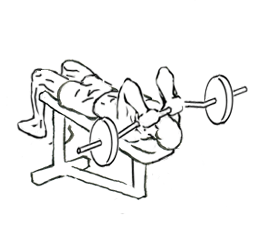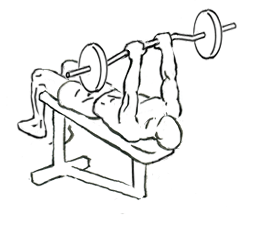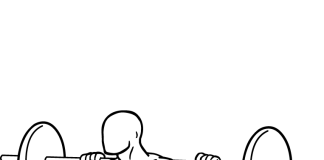Last Updated on September 30, 2014
The decline close grip bench to skull crusher is a powerhouse exercise that combines two highly effective movements for building upper body strength and muscle definition: the close grip bench press and the skull crusher. This combination targets both your chest and triceps, giving you the best of both worlds in a single movement. It’s perfect for lifters looking to increase triceps strength while also working on their chest muscles.
In this comprehensive guide, we will break down the benefits, proper technique, common mistakes to avoid, and how to incorporate this exercise into your workout routine for maximum results. Let’s dive into why this hybrid exercise deserves a spot in your training program!
What Is the Decline Close Grip Bench to Skull Crusher?
The decline close grip bench to skull crusher is a hybrid exercise that combines the close grip bench press and the skull crusher (lying triceps extension). By incorporating both movements into one exercise, you get a challenging workout for your chest and triceps.
- The close grip bench press focuses primarily on the triceps but also engages the chest and shoulders. This movement requires you to press the barbell using a narrower grip than the traditional bench press.
- The skull crusher targets the triceps through an elbow extension, providing deep muscle engagement.
By combining both exercises, you engage the chest during the pressing portion of the movement, while the skull crusher isolates the triceps for full-arm engagement. This makes it an incredibly efficient exercise for building upper body strength, particularly in the chest, shoulders, and arms.
Muscles Worked During Decline Close Grip Bench to Skull Crusher
This exercise targets several key muscles:
- Triceps Brachii: This is the primary muscle worked in both the close grip bench press and the skull crusher. The triceps, located at the back of your upper arms, are responsible for extending your elbows, and this exercise hits all three heads of the triceps—lateral, long, and medial.
- Pectoralis Major (Chest): While the focus is on the triceps, the chest muscles still play an important supporting role during the press portion of the exercise, particularly the lower chest due to the decline angle.
- Anterior Deltoids (Shoulders): The front part of the shoulder engages during the pressing motion, stabilizing the weight and assisting the triceps and chest.
- Core and Stabilizer Muscles: Your core muscles, as well as stabilizing muscles in your shoulders and chest, are engaged to keep your body stable on the decline bench.
Benefits of Decline Close Grip Bench to Skull Crusher
This hybrid exercise offers several key benefits, especially for those looking to maximize their chest and triceps development:
- Efficient Use of Time: By combining two exercises into one, you save time while still targeting both your chest and triceps effectively. This is great for those on a tight schedule but still wanting a comprehensive upper body workout.
- Triceps Overload: The decline close grip bench to skull crusher places a significant focus on the triceps, making it an excellent exercise for building size and strength in this often-overlooked muscle group.
- Increased Chest Engagement: The close grip bench press portion targets the chest, particularly the lower chest, while the triceps do the majority of the work during the press. This dual focus ensures you’re building upper body strength in multiple areas at once.
- Improved Elbow Stability: Both portions of this exercise require controlled movement, especially at the elbows. Over time, this can help strengthen and stabilize your elbow joints, which is particularly beneficial for heavy lifters.
- Core Stability and Balance: Performing this exercise on a decline bench forces your core to engage to stabilize your body, providing additional benefits beyond just the upper body muscles.
Proper Technique for Decline Close Grip Bench to Skull Crusher
Performing the decline close grip bench to skull crusher correctly is essential to maximize muscle activation and prevent injury. Follow these steps to ensure proper form:
- Set up the decline bench: Begin by adjusting the bench to a decline angle, typically around 15 to 30 degrees. Ensure the bench is stable and your feet are secured under the footpads for support.
- Grip the bar: Lie back on the bench and grip the barbell with an overhand grip, keeping your hands about 8 to 12 inches apart. This close grip targets the triceps while still engaging the chest. Ensure your wrists are straight, and your forearms are aligned with the bar.
- Lower the bar to your chest: Keeping your elbows tucked close to your sides, slowly lower the barbell to the lower part of your chest—about an inch below your nipples. Focus on maintaining control throughout the movement and avoid flaring your elbows.
- Press the bar up: Push the barbell back to the starting position in a controlled manner, focusing on using your triceps to press the weight. Do not lock out your elbows at the top; keep a slight bend to maintain tension.
- Transition into the skull crusher: At the top of the movement, bend your arms at the elbows, lowering the barbell toward your forehead or just behind your head (hence the name skull crusher). Keep your upper arms stationary, and use only your elbows to perform the movement.
- Extend back to the start: Raise the barbell back up by straightening your arms, returning the barbell to its position above your chest.
- Repeat the sequence: After completing the skull crusher portion, lower the bar back to your chest and repeat the entire sequence. Aim for 8 to 12 reps, depending on your strength level and fitness goals.
Common Mistakes to Avoid
To get the most out of the decline close grip bench to skull crusher and avoid injury, it’s important to maintain proper form. Here are some common mistakes to watch out for:
- Flaring the Elbows: Allowing your elbows to flare out during the close grip bench press portion takes the focus off your triceps and can put unnecessary strain on your shoulders. Keep your elbows tucked close to your body throughout the movement.
- Lifting Too Much Weight: This is a complex exercise that requires control and stability. Using too much weight can lead to improper form, which increases the risk of injury. Start with a manageable weight and focus on mastering the technique before increasing the load.
- Inconsistent Range of Motion: Shortening the range of motion reduces the effectiveness of the exercise. Make sure to fully extend your arms at the top of the press (without locking your elbows) and lower the bar all the way to your chest during the bench press portion.
- Poor Control During Skull Crushers: The skull crusher requires precise movement, especially when lowering the bar toward your head. Avoid swinging or rushing through this portion, and keep the movement slow and controlled.
- Arching Your Back: While a slight arch in the lower back is natural, excessive arching can strain your spine. Keep your core engaged and maintain a neutral spine throughout the exercise.
Variations of Decline Close Grip Bench to Skull Crusher
Once you’ve mastered the standard version, you can try these variations to keep your workouts challenging and target your muscles from different angles:
- Decline Dumbbell Close Grip Bench to Skull Crusher: Use dumbbells instead of a barbell to increase the difficulty. Dumbbells require more stability and can help correct muscle imbalances by working each side of the body independently.
- Incline Close Grip Bench to Skull Crusher: Perform the exercise on an incline bench instead of a decline. This variation shifts the focus to the upper chest while still engaging the triceps.
- Paused Reps: Add a pause at the bottom of the press or the skull crusher to increase time under tension, which can lead to greater muscle growth and strength gains.
- Single-Arm Skull Crushers: Perform the skull crusher portion using one arm at a time. This variation increases the challenge for your triceps and enhances balance and stability.
How to Incorporate the Decline Close Grip Bench to Skull Crusher into Your Workout Routine
The decline close grip bench to skull crusher is a versatile exercise that can fit into a variety of upper body and triceps-focused workouts. Here’s how to incorporate it into your routine:
- Frequency: Aim to include this exercise 1 to 2 times per week in your upper body or chest/triceps workouts. If your goal is muscle growth, consistency is key.
- Reps and Sets: For building muscle, aim for 3 to 4 sets of 8 to 12 reps. For strength training, opt for 4 to 5 sets of 4 to 6 reps with heavier weight.
- Pair with Complementary Exercises: Combine this exercise with other chest and triceps movements, such as the flat or incline bench press, overhead triceps extensions, or dips, for a well-rounded upper body workout.
- Rest Between Sets: Allow 1 to 2 minutes of rest between sets to ensure you maintain proper form and recover adequately.
Is the Decline Close Grip Bench to Skull Crusher Right for You?
This exercise is ideal for those looking to build upper body strength, particularly in the triceps and chest. However, beginners should start with lighter weights or simpler exercises to build a foundation of strength before attempting this more complex movement. Always listen to your body, and if you experience any discomfort in your elbows or shoulders, consult with a fitness professional.
Whether you’re a seasoned lifter looking to add variety to your routine or a beginner aiming to strengthen your upper body, the decline close grip bench to skull crusher is an excellent choice. The key to success with this exercise is to focus on form and control, ensuring that each movement is performed correctly for maximum muscle engagement and minimal risk of injury.
Final Tips for Success
- Start Light and Progress Gradually: If you’re new to this exercise, start with lighter weights to get a feel for the movement and perfect your form. As you gain strength and confidence, gradually increase the weight to continue challenging your muscles.
- Use a Spotter: If you’re lifting heavier weights, especially with a barbell, it’s always a good idea to have a spotter nearby to assist if you lose control or get fatigued during the set.
- Focus on the Triceps: Although the close grip bench press portion involves the chest, the primary focus of this exercise should be the triceps. Concentrate on squeezing and engaging your triceps during both the pressing and skull crusher movements.
- Warm Up Properly: Before attempting this exercise, make sure to warm up your chest, shoulders, and triceps with some light cardio and dynamic stretches. This will help prevent injury and improve your performance during the workout.
- Stay Consistent: Like any exercise, the key to progress is consistency. Incorporate the decline close grip bench to skull crusher into your regular workout routine, and over time, you’ll notice significant improvements in your upper body strength and muscle definition.
The decline close grip bench to skull crusher is an advanced, efficient, and highly effective exercise that delivers impressive results for your chest and triceps. By combining two powerful movements into one seamless exercise, you can maximize your time in the gym while targeting multiple muscle groups in one go. With proper form, gradual progression, and a focus on muscle engagement, this hybrid exercise can help you reach your upper body strength goals and take your fitness routine to the next level.
Give it a try in your next workout, and enjoy the benefits of building a stronger, more defined chest and triceps!







